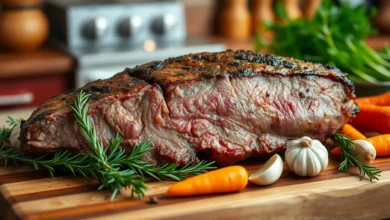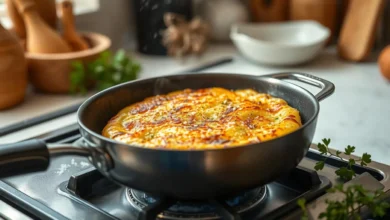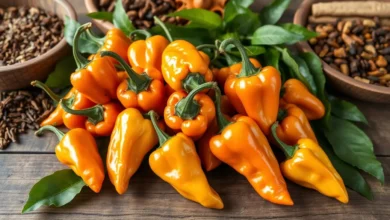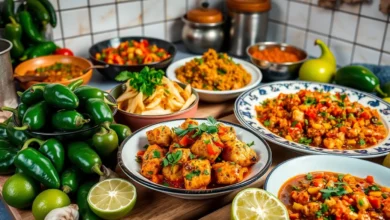How to Cook a Perfect Blade Roast Every Time
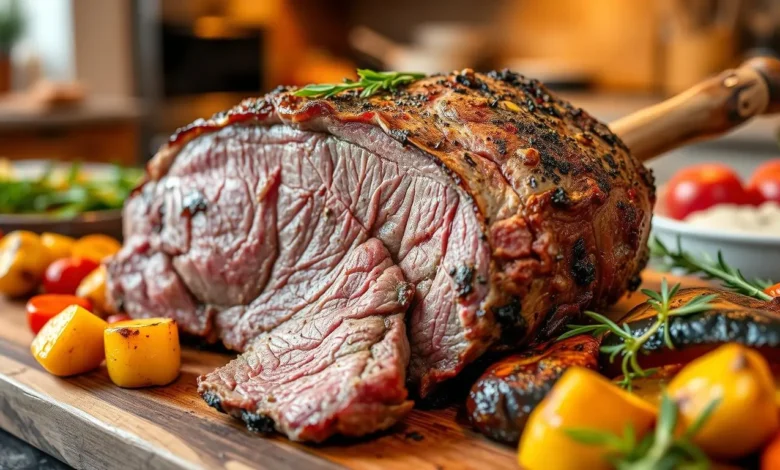
Australians love the blade roast for its great taste and softness. It’s a cut of beef that’s easy to cook and makes meals special. In this guide, we’ll show you how to make a blade roast that will wow your loved ones.
Understanding Blade Roast: What Makes It Special
At the heart of a succulent blade roast lies a world of culinary intrigue. This versatile cut, from the shoulder of beef, has a unique flavour and texture. It’s different from other roasting options. As we explore its anatomy and nutritional benefits, you’ll see why it’s a culinary gem.
Anatomy of a Quality Blade Cut
The blade roast, also known as the chuck roast, comes from the beef shoulder. This area has well-exercised muscles, giving it marbling and robust flavour. The mix of lean meat and fat makes it tender, juicy, and full of flavour.
Nutritional Benefits and Meat Characteristics
The blade roast is not just tasty; it’s also nutritious. It’s packed with protein, vitamins, and minerals, making it great for a balanced diet. Its texture and marbling work well with many cooking methods, making it a versatile kitchen star.
| Nutrition Facts (per 100g) | Blade Roast | Sirloin Steak |
|---|---|---|
| Calories | 192 | 242 |
| Protein | 26g | 25g |
| Fat | 10g | 15g |
| Iron | 2.3mg | 1.9mg |
The blade roast has a great nutritional profile, making it a smart choice for health-conscious eaters. It’s balanced in macronutrients and rich in minerals. This means you can enjoy a delicious and nourishing meal with every serving.
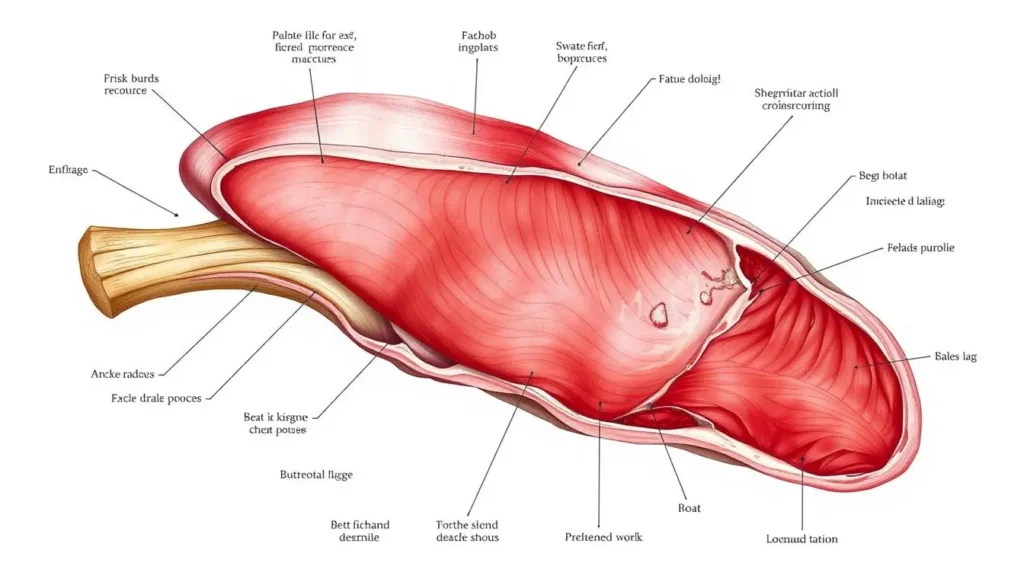
“The blade roast is a true unsung hero of the beef world, offering remarkable flavour and versatility at an exceptional value.”
Essential Equipment and Tools for Roasting
Cooking a delicious blade roast is easier with the right tools. A good roasting pan and a meat thermometer are key. They help us get amazing results every time.
Choosing the Right Roasting Pan
A top-notch roasting pan is essential for a blade roast. Choose a heavy, oven-safe pan that’s built to last. A pan with a tight lid helps cook evenly and keeps moisture in.
Monitoring Temperature with a Meat Thermometer
Getting the meat just right is crucial. A meat thermometer is vital. Go for a digital probe thermometer to check the meat’s internal temperature. This ensures it’s cooked perfectly.
Additional Kitchen Tools for Roasting
- Sharp carving knife for slicing the roast
- Basting brush for regularly basting the meat
- Aluminum foil or parchment paper for covering the pan
- Oven mitts or kitchen towels for handling hot surfaces
With these kitchen tools, we’re set to make a blade roast that will wow everyone.

“The right tools can make all the difference in the kitchen, especially when it comes to roasting a perfect blade cut.”
Selecting the Perfect Blade Roast at Your Local Butcher
Choosing a quality blade roast is easier with your local butcher’s help. They know how to pick the right cut for you. Let’s look at what to consider when picking the best blade roast.
Size and Marbling Considerations
The size of the blade roast matters. Choose one that will feed everyone well, with enough for seconds. Also, look at the marbling. More fat makes the meat tender and tasty.
Age and Colour Indicators
Check the colour of the roast. A bright, cherry-red colour means it’s fresh and good quality. Stay away from dull or brown meat. Your butcher can tell you about the beef’s age and how it will taste.
Premium vs Budget Options
- Premium blade roasts: These come from young, high-quality cattle. They have lots of marbling and taste great. They cost more but are worth it.
- Budget-friendly blade roasts: These might not have as much marbling but still taste good. Your butcher can suggest affordable options that are still tasty.
Choose a blade roast that fits your budget and taste. Working with your local butcher and considering these points will help you pick the perfect roast for your dinner.
| Consideration | Premium Blade Roast | Budget Blade Roast |
|---|---|---|
| Marbling | Excellent, evenly distributed | Moderate, may have less even distribution |
| Tenderness | Exceptionally tender | Reasonably tender when cooked properly |
| Flavour | Intensely flavourful | Good, but may not have the same depth of flavour |
| Price | Higher | Lower |
Proper Preparation Techniques Before Cooking
Getting your blade roast ready before cooking is key for tender, juicy, and tasty results. Let’s look at the important steps to make sure your meat is prepared well.
First, we need to trim excess fat. A bit of fat adds richness and moisture, but too much makes it greasy. Use a sharp knife to remove big chunks of fat, leaving a thin layer for flavour and tenderness.
Then, we focus on tenderising the meat. Blade roast is a bit tougher, so we need to soften the muscle fibres. Try gently pounding the roast with a meat mallet or scoring it in a criss-cross pattern. This helps the seasonings and marinade get in deeper, making the meat tender and flavourful.
Lastly, bring the meat to room temperature before cooking. Putting a cold roast in a hot oven can cause uneven cooking and bad texture. Let your blade roast sit at room temperature for at least 30 minutes before cooking. This ensures it cooks evenly from the inside out.
| Preparation Step | Purpose |
|---|---|
| Trim Excess Fat | Achieve the perfect balance of flavour and texture |
| Tenderise the Meat | Break down tough muscle fibres for a more tender result |
| Bring to Room Temperature | Ensure even cooking from the inside out |
By following these essential steps, you’ll cook a perfectly tender and flavourful blade roast every time.
The Art of Seasoning Your Blade Roast
Unlocking the full flavour of your blade roast starts with seasoning. We’ll show you the best ways to bring out the natural beefiness. From classic herb and spice mixes to marinades, we’ve got you covered.
Classic Herb and Spice Combinations
Seasoning your blade roast is all about keeping it simple. A mix of aromatic herbs and warm spices can make the beef taste amazing. Try garlic, rosemary, thyme, and black pepper for a flavour that’s both comforting and sophisticated.
For a bit of heat, use paprika, chili powder, and a pinch of cayenne. Or, try mustard powder, coriander, and fennel seeds for a unique taste.
Marinade Options and Timing
Marinades are great for adding extra flavour enhancers to your blade roast. A simple mix of red wine, soy sauce, and brown sugar tenderizes the meat and adds a rich crust. For an Asian twist, use soy sauce, rice vinegar, ginger, and garlic.
Marinate your roast for at least 4 hours, or up to 24 hours for the best flavour. Pat the roast dry before cooking to get a nice crust.
| Marinade Ingredient | Flavour Profile | Marinating Time |
|---|---|---|
| Red wine, soy sauce, brown sugar | Rich, caramelized | 4-24 hours |
| Soy sauce, rice vinegar, ginger, garlic | Asian-inspired | 4-24 hours |
| Olive oil, lemon juice, herbs, spices | Mediterranean | 4-24 hours |
The secret to great beef seasoning is finding the right flavour mix and letting the marinades work their magic. Try different mixes to find your perfect blend.
Temperature Guidelines and Cooking Times
To roast a blade cut perfectly, you need to know the right roasting temperature and cooking duration. Our expert tips will help you make a juicy, tender blade roast. You’ll get it cooked just the way you like it.
For a rare to medium-rare blade roast, set your oven to 450°F (230°C). This high temperature sears the outside while keeping the inside juicy. Cook it for about 20-25 minutes per pound (450g), depending on its size.
If you want your blade roast medium or well-done, lower the oven temperature to 325°F (165°C). This gentle cooking makes the roast evenly cooked, with a warm centre. Cooking time will be 30-35 minutes per pound (450g).
Always use a meat thermometer to check the internal temperature. For rare, aim for 120-125°F (49-52°C). For medium-rare, 130-135°F (54-57°C). Medium is 140-145°F (60-63°C), and well-done is 160°F (71°C) or higher.
| Doneness | Oven Temperature | Cooking Duration (per pound/450g) | Internal Temperature |
|---|---|---|---|
| Rare | 450°F (230°C) | 20-25 minutes | 120-125°F (49-52°C) |
| Medium-Rare | 450°F (230°C) | 20-25 minutes | 130-135°F (54-57°C) |
| Medium | 325°F (165°C) | 30-35 minutes | 140-145°F (60-63°C) |
| Well-Done | 325°F (165°C) | 30-35 minutes | 160°F (71°C) or higher |
These are just guidelines. The actual cooking duration can vary. It depends on the roast’s size, thickness, and your oven settings. Always check with a meat thermometer to get the perfect doneness.
Best Methods for Achieving Perfect Doneness
Getting the perfect doneness for your blade roast is crucial. It makes the meat juicy, tender, and full of flavour. Two key methods are using a meat thermometer and letting it rest for a while.
Using a Meat Thermometer
A meat thermometer is a must-have for cooking a blade roast. It helps you check the internal temperature accurately. This ensures the meat is cooked just right, not too hard or too soft.
Stick the thermometer into the thickest part of the roast, but avoid bone or fat. For a medium-rare, aim for a internal temperature of 55-60°C. Medium is 60-65°C, and well-done is 70°C and up.
Resting Period Importance
Letting your blade roast rest for 10-15 minutes after cooking is vital. This time lets the juices spread evenly, making the meat tender and flavourful. Don’t cut into the roast right away – waiting will make it juicier.
Try different cooking ways like slow roasting or reverse searing. Find what works best for you and the internal temperature and resting time you prefer. With practice, you’ll get a perfectly cooked blade roast every time.
Common Mistakes to Avoid When Cooking Blade Roast
Cooking a perfect blade roast is a joy, but mistakes can happen. We’re here to help you avoid these errors. This way, your blade roast will always be a hit.
One big mistake is overcooking the roast. This makes it dry and tough. Use a meat thermometer and follow the temperature guidelines. Take the roast out of the oven just before it’s done. This ensures it stays tender.
Another mistake is not seasoning enough. Blade roast needs good herbs and spices to taste great. Don’t hold back on seasoning. Try garlic, rosemary, and thyme for a tasty crust.
- Make sure to season all parts of the roast, including the sides and ends.
- Marinating the roast before cooking adds extra flavour.
Lastly, not letting the roast rest is a big mistake. Letting it rest for 10-15 minutes makes it juicier. This is key for a tender dish.
| Common Cooking Errors | Solutions |
|---|---|
| Overcooking the roast | Use a meat thermometer and remove the roast just before desired doneness |
| Inadequate seasoning | Generously season the roast with a blend of herbs and spices; consider marinating |
| Failing to let the roast rest | Allow the roast to sit for 10-15 minutes before slicing |
Avoid these mistakes and you’ll roast a blade roast that’s tender and full of flavour. With practice and our tips, you’ll be a pro in no time!
Serving Suggestions and Side Dish Pairings
There are many ways to serve your perfectly cooked blade roast. We’ve picked out some classic sides and new ideas to wow your guests. These options highlight the rich, tender flavour of this premium cut.
Traditional Accompaniments
- Roasted seasonal vegetables, like carrots, potatoes, and Brussels sprouts, make a classic roast dinner.
- Creamy mashed potatoes go well with the juicy, savoury blade roast.
- A fresh green salad with tangy vinaigrette offers a refreshing contrast to the hearty meat.
- Yorkshire puddings, a quintessential British side, soak up the natural pan juices.
Modern Plating Ideas
For a modern twist, try these serving suggestions:
- Slice the blade roast thinly and place it on a bed of vibrant quinoa or wild rice.
- Pair the roast with a colourful salad of mixed greens, roasted beets, and crumbled feta cheese.
- Drizzle a flavourful chimichurri sauce over the sliced blade roast for a burst of freshness.
- Enjoy the tender roast with creamy, garlic-infused mashed cauliflower for a low-carb option.
Whether you choose classic sides or modern plating, the key is to highlight the blade roast’s flavour. A bit of creativity and attention to detail can make your meal unforgettable.
| Side Dish | Flavour Profile | Presentation Tip |
|---|---|---|
| Roasted Vegetables | Earthy, comforting | Arrange vegetables in a colourful pattern on the serving platter |
| Mashed Potatoes | Creamy, indulgent | Pipe the potatoes into decorative swirls on the plate |
| Quinoa Salad | Nutty, fresh | Garnish with fresh herbs and pomegranate seeds for a vibrant touch |
| Chimichurri Sauce | Bright, herbaceous | Drizzle the sauce in an artistic pattern around the sliced roast |
Storing and Reheating Leftover Roast
Enjoying your delicious blade roast doesn’t have to stop after the first meal. With the right food storage and reheating, you can keep the flavour and tenderness for days. This way, you can enjoy it even longer.
To store your leftover roast, wrap it tightly in foil or use an airtight container. This keeps the moisture in and prevents drying. Refrigerate it and eat it within 3-4 days for the best taste. To reheat, use the oven at a low temperature or the stovetop with broth or gravy.
For a lot of leftover roast, think about making new dishes. Shredded or diced roast is great in soups, stews, tacos, or sandwiches. It’s a fun way to make your leftover roast into tasty meals that everyone will love.
FAQ
What makes a blade roast special?
Blade roast is special because of its marbling, tenderness, and flavour. It comes from the cow’s shoulder. This cut has the right mix of fat and lean muscle, making it delicious.
What equipment do we need to cook a perfect blade roast?
To cook a great blade roast, you’ll need a few things. A heavy-duty roasting pan, a meat thermometer, and sharp knives are key. These tools help get the roast just right.
How do we select the best blade roast at the butcher?
When picking a blade roast, look for good marbling, a deep red colour, and firm texture. Consider the size and weight too. This ensures you get the perfect roast.
What’s the best way to prepare the blade roast before cooking?
Before cooking, trim excess fat, tenderise the meat, and let it come to room temperature. These steps help with even cooking and better taste and texture.
How do we season and marinate a blade roast?
You can season or marinate a blade roast in many ways. Use herbs, spices, or marinades to boost its flavour. Just make sure to let it soak long enough.
What temperature and cooking time should we use for a blade roast?
Cooking temperature and time depend on your preference. Roast at 425°F (220°C) for 30 minutes, then at 325°F (165°C) for the rest. Cooking time varies with roast size and desired doneness.
How do we ensure the perfect doneness of a blade roast?
Use a meat thermometer for perfect doneness. Insert it into the thickest part of the roast. Let it rest for 15-20 minutes after cooking to keep it juicy.
What are some common mistakes to avoid when cooking a blade roast?
Avoid overcooking, not resting the meat enough, and bad seasoning or marinating. These mistakes can ruin a tender and juicy roast.
What are some delicious side dish and serving suggestions for a blade roast?
Pair the roast with roasted veggies like potatoes, carrots, and onions. For something different, try a fresh salad or roasted garlic mashed potatoes. Slice the roast and arrange it with your chosen sides for a great look.
How do we properly store and reheat leftover blade roast?
Store leftover roast in an airtight container in the fridge for 3-4 days. Reheat it gently in the oven or microwave. This keeps it juicy and flavourful.
